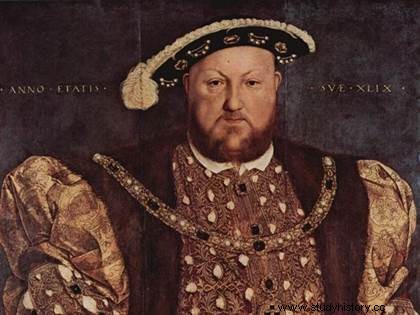 King of England from 1509 to 1547, Henry VIII is best known for his complicated relationship with his wives, since he had two executed, and the annulment of his first marriage was the cause of the schism with Rome. Nevertheless, Henry VIII was also the king of an England who had the will to pose as an arbitrator in the fight between Charles V and François Ier in the context, decisive for Europe, of the Reformation. The crisis with Rome was to lead to the creation of Anglicanism, ratified under the reign of the daughter of Henry VIII, Elizabeth I . Finally, it was under his reign that the expansion of the British Navy began.
King of England from 1509 to 1547, Henry VIII is best known for his complicated relationship with his wives, since he had two executed, and the annulment of his first marriage was the cause of the schism with Rome. Nevertheless, Henry VIII was also the king of an England who had the will to pose as an arbitrator in the fight between Charles V and François Ier in the context, decisive for Europe, of the Reformation. The crisis with Rome was to lead to the creation of Anglicanism, ratified under the reign of the daughter of Henry VIII, Elizabeth I . Finally, it was under his reign that the expansion of the British Navy began.
Henry VIII, heir to the Tudors
Just like his daughter Elisabeth, Henry VIII is not the first heir to the throne. Indeed, the second son of Henry VII, he came after his brother Arthur, the sovereign's favorite son, who did not hesitate to place him as a distant heir to the legendary king of the same name. Pressed to ensure his succession, King Henry VII marries Arthur to the daughter of the Catholic Monarchs, Catherine of Aragon. We are in 1501, the two spouses are not sixteen years old, their union full of promise for the two kingdoms is well received in England, until Thomas More, who sees in Catherine "all the qualities which make the beauty of a charming young girl”.
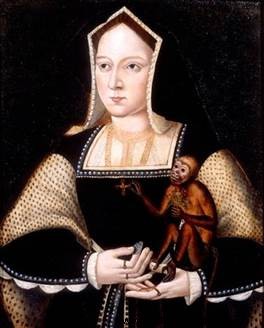 Still, drama intervenes. In fragile health, the young Arthur dies five months after his marriage! The King of England, his grief past, negotiates with Isabella the Catholic so that she agrees to remarry her daughter with the new heir, Henry. They were engaged in 1503, and the marriage must be recorded when the future sovereign is fifteen years old. Spain is counting on this union to ultimately indirectly control England. Things get complicated when Henry VII dies in April 1509. His son girds the crown of England, and must marry Catherine as planned, under pressure, and not without some questions. After all, he marries the wife of his deceased brother... The union is nevertheless celebrated in June 1509, and the couple crowned fifteen days later in Westminster.
Still, drama intervenes. In fragile health, the young Arthur dies five months after his marriage! The King of England, his grief past, negotiates with Isabella the Catholic so that she agrees to remarry her daughter with the new heir, Henry. They were engaged in 1503, and the marriage must be recorded when the future sovereign is fifteen years old. Spain is counting on this union to ultimately indirectly control England. Things get complicated when Henry VII dies in April 1509. His son girds the crown of England, and must marry Catherine as planned, under pressure, and not without some questions. After all, he marries the wife of his deceased brother... The union is nevertheless celebrated in June 1509, and the couple crowned fifteen days later in Westminster.
The young king is no less legitimate and popular, unlike a reclusive father who has become devout. Henry VIII, on the other hand, is young, tall and handsome, almost seen as a new messiah according to Thomas More. But is he ready to govern?
The king's entourage
Barely on the throne, Henry VIII decides to do the opposite of his father. He frees political prisoners, arrests others, including those he considers corrupt, such as Edmund Dudley and Richard Empson, who are quickly executed. He then recalls the Marquis Thomas Grey, estranged by his father. On the other hand, it retains Chancellor William Warham (Archbishop of Canterbury) and Richard Foxe. At the start of his reign, Henry VIII intended to profit rather than govern.
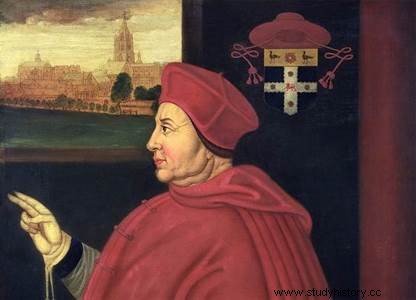 The king will however know how to surround himself with competent men, even if he will not hesitate not to get rid, sometimes radically, of some of them. We can cite Thomas Wosley, Thomas Cromwell, and of course Thomas More. However, Henry VIII is determined to govern above all for his personal glory, and thus rise to the level of his European rivals. The international context quickly gave him the opportunity.
The king will however know how to surround himself with competent men, even if he will not hesitate not to get rid, sometimes radically, of some of them. We can cite Thomas Wosley, Thomas Cromwell, and of course Thomas More. However, Henry VIII is determined to govern above all for his personal glory, and thus rise to the level of his European rivals. The international context quickly gave him the opportunity.
The break with Rome
The "big deal" of Henry VIII's reign was the schism with Rome. But the reasons are multiple and complex, and not only due to a whim to remarry. First of all, the agreement is not excellent between the king and Catherine of Aragon, just like the relations with the father of this one, especially between 1511 and 1514. Henri VIII is not the docile prince that the Spaniards hoped. Moreover, he reproaches the queen for not giving him a son (a boy died a few weeks old in 1511); however, they have a daughter, Marie, born in 1516. Everything accelerates when the king falls in love with Anne Boleyn...
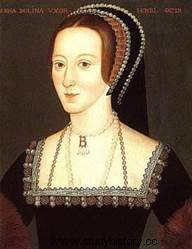
At the same time, the Reformation progressed in Europe, as far as England. If Henry VIII fights it fiercely, placing himself as a "defender of the Faith", he does not line up behind the pope either, whose supremacy he begins to contest, with the support of Wosley.
The turning point came in 1527, when Henry VIII decided to annul his marriage to Catherine of Aragon, causing scandal with Rome and Spain, now under the thumb of the Emperor Charles V. The King of England instructs Wosley to negotiate with Pope Clement VII. The law is intertwined with political intrigue and power struggles between Henry VIII and Charles V (who refused to marry Marie Tudor). The pope chooses the latter after several years which see the disgrace of Wosley, to the benefit of More and especially Cromwell.
In 1531, the Archbishop of Canterbury Thomas Cranmer declared:"We acknowledge that His Majesty is the particular Protector, the only and supreme Lord and, as much as the law of Christ the permits, the Supreme Head of the Church and Clergy of England”. Cranmer was instrumental in the separation of the Church of England from the Roman Catholic Church during the reign of Henry VIII. He paved the way for the liturgical book of the Church of England, the Prayer Book, by first revising various medieval and contemporary breviaries and liturgical books.
Consumed by the Act of Supremacy in 1534, the schism was there, and the Pope excommunicated Henry VIII.
Henry VIII's foreign policy
The end of the 15th century saw the outbreak of the Italian wars and the ambitions of France. In a hurry to enter the international game, seeing it as an opportunity to acquire prestige, Henry VIII joined the League that Pope Julius II had set up against Louis XII in 1511. However, he had to wait until 1513 to land in France, where he takes Thérouanne. This is the opportunity to start propaganda to his glory, presenting his victory as a new Agincourt. However, he had to return urgently to England under Scottish threat, and could not really take advantage of his prestigious victory. He nevertheless gained a great aura in his kingdom, celebrated as a new Henry V. The King of England then spent a large part of his reign playing the balance between the two continental powers, France and the Empire.
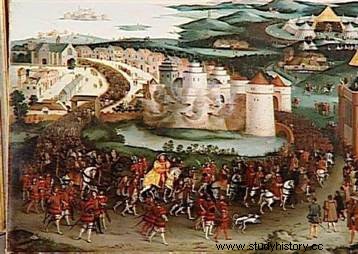 Henry VIII not only wanted to make England a great power, he also posed as a prince in competition with the other princes, in particular with the king of France François Ier, with a similar profile. The two sovereigns met at the Camp du Drap d'Or in June 1520, where they competed in ostentatious luxury. However, Henry chose his camp, following the defeat of Francis I at Pavia (1525), and approached the emperor through the Treaty of Westminster in 1527. The crisis with the papacy nevertheless showed the limits of the strategy of 'Henry VIII. Its influence remains relative, against the Empire, but also against France, once Francis I was freed.
Henry VIII not only wanted to make England a great power, he also posed as a prince in competition with the other princes, in particular with the king of France François Ier, with a similar profile. The two sovereigns met at the Camp du Drap d'Or in June 1520, where they competed in ostentatious luxury. However, Henry chose his camp, following the defeat of Francis I at Pavia (1525), and approached the emperor through the Treaty of Westminster in 1527. The crisis with the papacy nevertheless showed the limits of the strategy of 'Henry VIII. Its influence remains relative, against the Empire, but also against France, once Francis I was freed.
England remained withdrawn from international affairs during the 1530s, then returned to the game in 1542. Until 1546, Henry VIII was involved in new military conflicts in France and Scotland. Married to a French princess, James V of Scotland indeed ravaged the English borders, which prompted Henry VIII to resume hostilities with Scotland's ally, Francis I.
In 1542, Henry defeated the Scots at the Battle of Solway Moss and then took the French city of Boulogne two years later. The strategic achievements are nevertheless relative:Boulogne is returned two years later and despite the English successes, Scotland remains independent. It is the last state in the British Isles to escape English domination, while Wales was attached to the Crown (Act of Union of 1536) and Henry VIII received the title of King of Ireland ( 1541).
Finally, if Henry VIII allowed England to hold up against the ambitions of his rivals, he did not manage to really compete with them. Worse, his efforts bled the kingdom dry…
"Bluebeard" and his wives
The "divorce" with Catherine of Aragon allows the king to formalize his affair with Anne Boleyn in 1533. He hopes for a son from her, but she gives birth to a daughter, Elizabeth. Their relationship quickly soured, Anne having a miscarriage in 1536. In addition, the reputation of the queen was increasingly sulphurous. Henry VIII took the opportunity to get rid of her, and she was executed in 1536, on the pretext of being accused of incest and adultery.
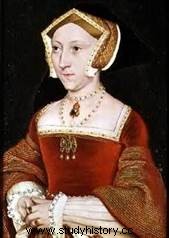 The king then sets his sights on Jeanne Seymour, with whom he falls very much in love. Miracle, she gave him a son, Edouard, in 1537! Unfortunately, she died the same year… Henry VIII never really recovered. The fourth marriage of Henry VIII, with Anne of Cleves, is political, to get closer to German Protestants. The queen is repudiated a few months later. Aged and weakened, Henry VIII tried to regain his youth and vigor with Catherine Howard in 1540. It was a fiasco, and the queen was executed in February 1542, as were her presumed lovers... The last lucky one, Catherine Parr, seems to give it some balance. Both spouses respect each other, and this time she survives him, passing away a year after the death of the king.
The king then sets his sights on Jeanne Seymour, with whom he falls very much in love. Miracle, she gave him a son, Edouard, in 1537! Unfortunately, she died the same year… Henry VIII never really recovered. The fourth marriage of Henry VIII, with Anne of Cleves, is political, to get closer to German Protestants. The queen is repudiated a few months later. Aged and weakened, Henry VIII tried to regain his youth and vigor with Catherine Howard in 1540. It was a fiasco, and the queen was executed in February 1542, as were her presumed lovers... The last lucky one, Catherine Parr, seems to give it some balance. Both spouses respect each other, and this time she survives him, passing away a year after the death of the king.
The downfall of Henry VIII
The king, since the disgrace of Thomas Wolsey, has increasingly complicated relationships with his advisers. Thus, Thomas More, then his rival Thomas Cromwell, were executed in 1535 and 1540 for sometimes obscure reasons. Until the end of his reign, Henry VIII continued the purges and ruled more and more alone, while his popularity was a distant memory, as the kingdom bent under taxes to finance wars. His decline is also physical following an injury received in a tournament:obese, impotent, he becomes a nightmare for those around him.
So it was a relief when Henry VIII died on January 28, 1547. He left a bloodless and divided kingdom. He was briefly succeeded by his son Edward (1547-1553) and Marie Tudor, known as “Bloody Mary” for her bloody return to Catholicism. Finally, Elizabeth I (1558-1603), daughter of Anne Boleyn, although she became one of the greatest queens of England and made her country a great power, did not manage to perpetuate the Tudor dynasty, which s 'off with it. In the meantime, his father has become a legend.
Bibliography
- B. Cottret, Henri VIII, power through force, Payot, 2005.
- G. Minois, Henri VIII, Fayard, 1989.
- G. Hocmard, Henry VIII. Biography Ellipses, 2018.
- L. Crété, The Tudors, Flammarion, 2010.
